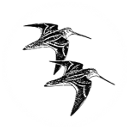Recent activities

Every picture tells a story…
…and this one is told by Alan Harris
Mid July and an untidy pile of pale grey–brown feathers on the grass indicates something rather terminal for some unlucky bird. Curiosity aroused, I go over for a look. Mmmm, Collared Dove feathers, judging by the colour, amount and size of the flight feathers. What took that then? This patch of grass is within the sight line of the pylon which is the current favourite perch of an adult female Peregrine. Or maybe the dove was ambushed by a Fox?
A close look sheds some clues. Amongst the Collared Dove feathers (neatly plucked out by a bird, not bitten off by a Fox) was a barred feather, a primary which was both strongly emarginated on the outer web, and well notched on the inner web. (An emargination is a narrowing of the outer web of a flight feather, whereas a notch is a step in the wider inner web.) The colouration suggested that it came from a grey or grey-brown bird. Peregrine Falcons exhibit indistinct emarginations on the outermost two primaries and a notch only on the outermost, their wing feather structure evidently linked to their more direct mode of pursuit flight and open hunting areas. This particular feather however, with its strong emargination and notch was far more suggestive of a hawk, an accipiter, and I identified it as having come from a Sparrowhawk. On Sparrowhawk, the outer four primaries are emarginated and notched, giving the hunting bird more manoeuvrability. This is advantageous for the quick changes of speed and direction required in confined spaces in woodland or hedgerow, allowing it to shed air or brake, or accelerate, all in an instant.
Imagine the scenario. A Collared Dove forages on the grass and is surprised by a low flying female Sparrowhawk. In mid-July she is probably feeding large young, just fledged or perhaps still in the nest. A Collared Dove is a big prey item for a male Sparrowhawk, but a regular item for the larger female – a male really would struggle to take one. The striking difference in size between the small males and the big females enables the pair to hunt the same ground without competing with each other, taking different sized prey, doubling up their capacity to hunt the territory.
Their size dimorphism also has a bearing on their breeding strategy. The male provisions the female while she incubates; she does not hunt whilst on eggs or when the young are small. She uses this ‘dead’ time by beginning her annual moult, getting a head start on the male. By the time the young are around two weeks old she has got a good deal of her moult done. At this time she begins to hunt again as the growing young need more food, and the male will now have to start his moult. Her moult is one primary (flight) feather at a time, so that she still has sufficient flight feathers for competent hunting at a crucial time when his contribution to lunch may begin to drop off.
Here one of her last outer primaries, already loose, falls out in the struggle, confirming her as the finely adapted top predator who took the dove.

That’s a really interesting piece of deduction! Wildlife Detective, eat your heart out!
My hearty congratulations to you. This is what blogging is really about. . My breakfast today was a couple of poached eggs on toast – 2 WA EP – You have to be a nest recorder to enjoy that, with Worcester sauce.
Toby.